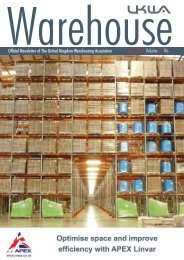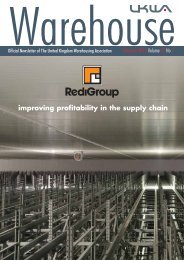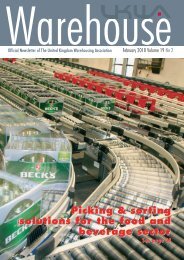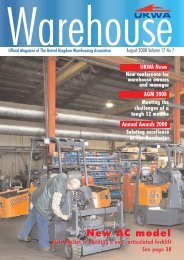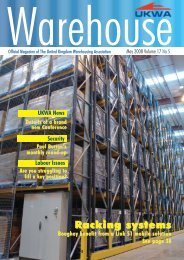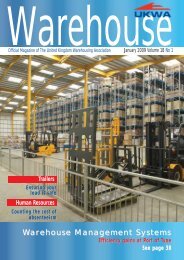ifwla - Warehousing and Logistics International
ifwla - Warehousing and Logistics International
ifwla - Warehousing and Logistics International
- No tags were found...
You also want an ePaper? Increase the reach of your titles
YUMPU automatically turns print PDFs into web optimized ePapers that Google loves.
50 Twintec AdvertorialTwintec Advisory Paper 1:21st Century Warehouses& Storage FacilitiesDarryl Eddy, Director, Twintec UKA modern 21st century warehouse is a very differentplace from its predecessor of the 1980s <strong>and</strong> 1990’s.Developments in logistics technology <strong>and</strong> software alongwith advances in storage systems <strong>and</strong> mechanicalh<strong>and</strong>ling equipment (MHE) have allowed manufacturers<strong>and</strong> distribution companies to become dramatically moreefficient.Racking systems are becoming higher, aisles narrower<strong>and</strong> automated systems commonplace, providingoperators with efficient stock retrieval <strong>and</strong> faster deliveryto the customer. These facilities are increasing in size interms of footprint <strong>and</strong> height. These facilities place muchgreater dem<strong>and</strong>s on the flooring system including muchmore aggressive surface wear, much higher loads beingimposed on the floor slab <strong>and</strong> an increase in the flatnesstolerances required.Another consideration that needs to be addressed insuch a fast moving industry is ‘future-proofing’.Continuing improvements in technology have led someconsultants to suggest that changes to the logistics systemsin a modern warehouse are needed every 5 – 10 years.This presents an additional problem for clients, tenants<strong>and</strong> third party logistics (3PL) companies <strong>and</strong> has a directbearing on the type of floor specified <strong>and</strong> constructed ina new facility. Most of the maintenance problems inindustrial concrete floors result from unevenness <strong>and</strong>disruptions of the surface, particularly at joints.For the operator of a modern distribution facility, downtime to repair the floor slab, or MHE damaged by a poorquality floor slab can be very disruptive. In addition, thecurling <strong>and</strong> breakdown of sawn joints in a traditionalsystem can cause major disruption for MHE in terms ofpicking speed. A further potential problem is the need torespect the designer’s criteria regarding proximity ofracking legs to floor joints; the more joints there are, thegreater the likelihood that conflicts could arise.Building owners are increasingly aware of suchproblems associated with saw-cut joints; therefore‘joint-free’ industrial flooring systems such as steel fibrereinforced concrete (SFRC) are becoming more frequentlyspecified <strong>and</strong> have proven to be a successful solution.A SFRC ‘joint-free’ slab is designed to eliminate theneed for saw cut induced contraction joints. The design isa well proven method with a thirty year track record.Eliminating the saw cut joints has a significant benefit tothe end user in terms of increased flexibility of use,improved toughness <strong>and</strong> durability <strong>and</strong> reducedmaintenance costs for both floor slab <strong>and</strong> forklifts.Adopting a SFRC ‘joint-free’ system will not onlyminimise the problems identified above, but also improvethe flexibility of the building in terms of ‘futureproofing’it.ConclusionThe quality <strong>and</strong> durability of a modern industrial floorslab is key to the success <strong>and</strong> efficiency of a modernlogistics facility. UK Concrete Society Technical Report No34 section 2.1 says that “an ideal floor would beperfectly flat <strong>and</strong> level <strong>and</strong> have no joints”. This is moreachievable with SFRC than with lightly reinforced floorslabs as it allows the elimination of saw-cut joints, <strong>and</strong>therefore ensures better long term flatness.However, once building owners, consulting engineers,architects <strong>and</strong> general contractors have decided to opt fora ‘joint-free’ SFRC slab, they must take precautions inchoosing the right specialist contractor for the job bycarefully reviewing the following items:• The contractor’s track record in ‘joint-free’ SFRC floors• Visit ‘joint-free’ reference floors <strong>and</strong> ask the opinion oftheir users• Check the site quality control procedures proposed bythe concrete contractor• Ensure that adequate site conditions will be in placebefore, during <strong>and</strong> after the works• Ensure early co-ordination takes place with thecontractor to optimise the detailed design <strong>and</strong>particularly adjoining interfaces• Limit the number of split responsibilities within thecontract• Be aware of <strong>and</strong> accept the possibilities of controlledcracksIf these factors are carefully considered, if theplanning <strong>and</strong> design process is integrated carefully withthe building <strong>and</strong> the logistics systems <strong>and</strong> if the correctcontractor <strong>and</strong> supply chain is selected, then the end resultwill be that everyone gets exactly what is best for theproject.Twintec Limited, Prospect Park, Valley Drive, Rugby,Warwickshire. CV21 1TFTel : 01788 567722 ▪ Email: mail@twintec.co.ukWebsite : www.twintec.co.ukIssue No. 3www.warehousinglogisticsinternational.com






